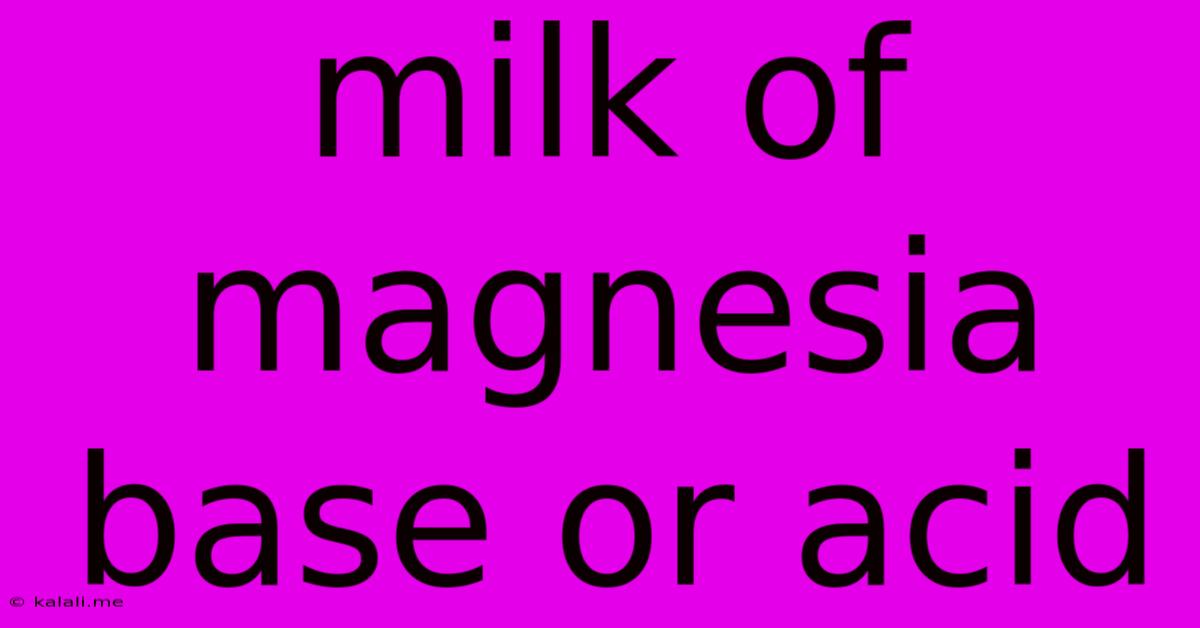Milk Of Magnesia Base Or Acid
Kalali
Jun 15, 2025 · 3 min read

Table of Contents
Milk of Magnesia: Base or Acid? Understanding its pH and Uses
Milk of Magnesia, a common household remedy, often sparks the question: is it an acid or a base? The answer is crucial for understanding its effects on the body and its various applications. This article will delve into the chemical nature of Milk of Magnesia, explaining its pH level and how that impacts its uses as an antacid and laxative. We'll also explore its safe and effective usage.
Milk of Magnesia is a suspension of magnesium hydroxide, Mg(OH)₂, in water. This compound is a strong base, meaning it readily accepts protons (H⁺ ions) in a chemical reaction. Its pH is significantly above 7, typically around 10. This high pH is the key to its effectiveness as both an antacid and a laxative.
Milk of Magnesia as an Antacid
When you ingest Milk of Magnesia, its high pH neutralizes stomach acid (hydrochloric acid, HCl). The reaction between the base (magnesium hydroxide) and the acid (hydrochloric acid) produces magnesium chloride, water, and heat. This neutralization process reduces the acidity in the stomach, providing relief from heartburn, indigestion, and acid reflux. This makes it a popular and effective over-the-counter antacid.
Milk of Magnesia as a Laxative
The magnesium ions in Milk of Magnesia also play a crucial role in its laxative properties. These ions draw water into the intestines, softening the stool and increasing bowel movements. This osmotic effect helps relieve constipation. The increased bulk and water content makes it easier for the bowels to eliminate waste.
Understanding Safe and Effective Usage
While generally safe, it's crucial to follow the recommended dosage on the product label. Overuse can lead to side effects such as diarrhea, nausea, and abdominal cramps. Individuals with certain health conditions, such as kidney disease, should consult a doctor before using Milk of Magnesia.
Important Considerations:
- Long-term use: Prolonged use of Milk of Magnesia as a laxative should be avoided, as it can lead to magnesium deficiency and other complications.
- Interactions: Milk of Magnesia can interact with certain medications, so it's essential to inform your doctor or pharmacist about all the medications you are taking.
- Pregnancy and breastfeeding: Pregnant or breastfeeding women should consult their healthcare provider before using Milk of Magnesia.
Milk of Magnesia vs. Other Antacids and Laxatives
Milk of Magnesia differs from other antacids and laxatives in its chemical composition and mechanism of action. While some antacids utilize other bases like aluminum hydroxide or calcium carbonate, Milk of Magnesia's magnesium hydroxide provides both antacid and laxative properties. Other laxatives work through different mechanisms, such as stimulating bowel contractions or lubricating the stool.
In conclusion, Milk of Magnesia is a strong base with a high pH, making it effective as both an antacid and a laxative. Understanding its chemical properties and potential side effects is crucial for safe and effective use. Always adhere to the recommended dosage and consult your doctor if you have any concerns or underlying health conditions. Remember to always prioritize your health and seek professional medical advice when needed.
Latest Posts
Latest Posts
-
Alloy Of Copper Tin And Zinc
Jun 15, 2025
-
Poissons Ratio Formula In Terms Of Youngs Modulus
Jun 15, 2025
-
Which Of The Following Can Be Inferred From The Figure
Jun 15, 2025
-
The Words We Use Are Called
Jun 15, 2025
-
A Word Processor Is An Example Of System Software
Jun 15, 2025
Related Post
Thank you for visiting our website which covers about Milk Of Magnesia Base Or Acid . We hope the information provided has been useful to you. Feel free to contact us if you have any questions or need further assistance. See you next time and don't miss to bookmark.